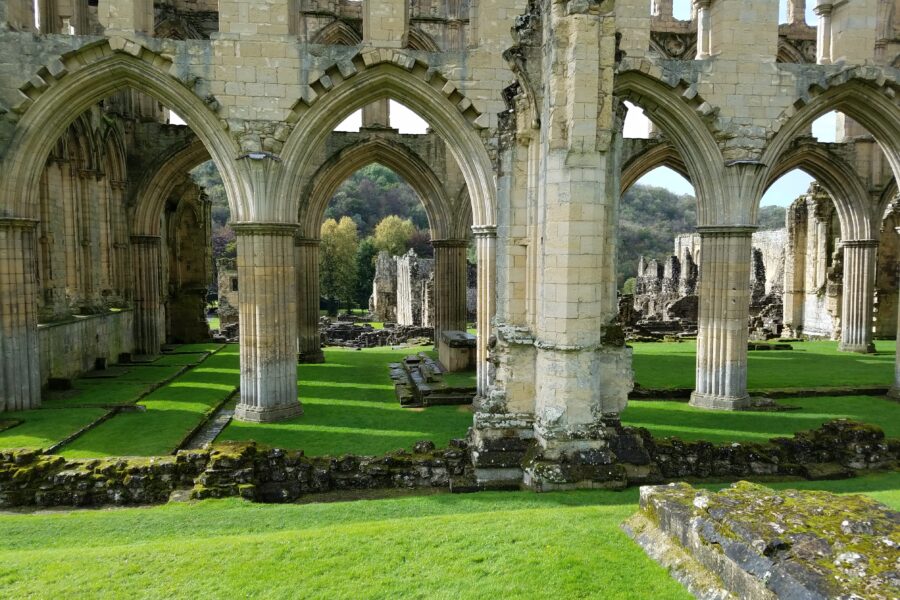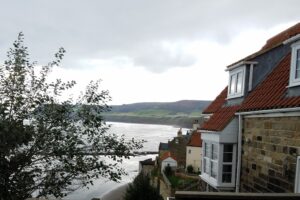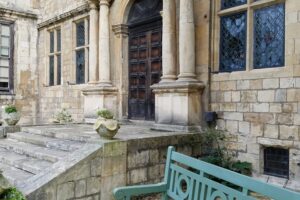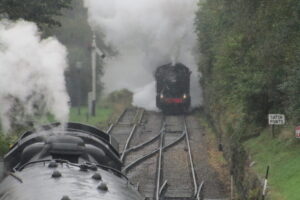Jeeves leaves us high and dry, taking us to a neighborhood with the moniker of Ormesby, rather than the Hall. Successfully navigating the old fashioned way, by following signs, we arrive at a large black iron gate that is locked tight—shouting both with the lock and a sign—CLOSED!
“It can’t be,” I say, “it’s a National Trust property.” I turn my phone off airplane mode in an effort to get answers. Closed on Thursday, Friday and Saturday. That is totally strange. Always flexible, Michael programs the GPS for our second destination, Helmsley, a town holding their Friday market today.
The rain persists, covering the hills with a fine silver veil. We travel down a curling road that weaves back and forth between the hills; a gift to my bucolic senses. Passing through Chop Gate, driving toward Fangdale Beck, not being able to stand it any longer—just sitting here and looking, doing nothing to preserve my memories—I ask Michael to stop if he sees an opportunity. I have a deep need to at least try and capture the essence of this day. It is pastoral heaven, and I am in heaven just being here. I happily tromp about in tall wet grass, scaring sheep. Trying.


When we see a sign to Rievaulx I point out that it too is supposed to be a National Trust property—I remember seeing white columns and a peaked roof on the brochure. We follow a single car down a narrow gray ribbon, passing by a cluster of old stone structures with some glimpses of ruins in the distance. We park the car in the small lot and walk toward the modern visitor center. Michael shows the attendant our National Trust card only to find this is an English Heritage site. While I wander around the gift shop, planning future purchases of tapestries and ginger liquer, Michael and the attendant have a long conversation.

“Well, if you just want to see the ruins from on top of the hill, you can go the National Trust site. But if you want to SEE the ruins, you need to pay here.” Because the English Heritage sites—like the National Trust sites—are everywhere, Michael hands over a membership fee and pays the fee to enter the site.
Armed with an audio tour—and I don’t care what the numbers on the signs say, I have learned to start at #1 and go forward, in order—we wander down a long gravel path toward the ruins of Rievaulx Abbey. The day has turned simply gorgeous. The air rain-washed fresh, the spring-green grass in autumn—wet wet wet. The sun teases—bright and brilliant at times, it disappears only to return only to disappear yet again—and return. The ruins of the ancient Cistercian Abbey are magnificent, dwarfing those on the windswept bluff high above Whitby. The location in this small hidden valley, so peaceful so tranquil so beautiful, takes my breath away. Wordsworth came and sat here; Turner painted here. I am humbled, walking among the ghosts of giants through the ages.

Rievaulx Abbey, founded in 1132, was the first Cistercian abbey to be established in the north of England. It quickly became one of the most powerful and spiritually renowned centres of monasticism in Britain.



Of course Henry VIII has been at work here, with his avaricious tendencies and destructive methods. However, I can’t help but think that the abbey in its desolation has an ethereal beauty that would elude it if it stood here whole—intact. Should I thank Henry or hate him? It’s a conundrum.

We travel slowly through the centuries, walking, sitting, standing; taking our time, trying to absorb all that we hear and see. Impossible.




The monastic impulse was long past its peak: excepting those run by stricter orders like the Carthusians, monasteries had become property-owning corporations – some very rich – with few inhabitants.

Cistercian ‘white monks’ (named after the colour of their habits) established, as their rule demanded, monasteries ‘far from the haunts of men’. These included Rievaulx Abbey, North Yorkshire, which by the 1160s housed 650 monks.
Armed with two bottles of English made liqueurs, a large tapestry pillow-covering, and a purple and white paper back book titled, Divorced, Beheaded, Died…The History of Britain’s Kings and Queens in Bite-Sized Chunks, we make our way to the car. We drive up, out of the valley toward the top of the hill and the hairpin turn that will take us to the National Trust site of Rievaulx Terrace.

The setting is spectacular— a wide expanse of green following the edge of a wooded escarpment which overlooks the valley below. The temple-like building at the edge of the sprawling terrace, constructed in 1758, was built as an elaborate dining room solely for the purpose of showing off the fashionable ruins of the abbey to visiting guests.



Michael and I stroll through the mist along the half mile length of the terrace toward another of the rich man’s follies, a smaller temple at the opposite end, stopping often to admire the various views of the ancient ruins below. We make our way back to the car and reality, using the secluded wooden path.


We always seem to stumble and drift and trip and tumble through our explorations—landing upright most of the time. I almost think it is better than planning, than knowing in advance what to expect. The element of surprise, something unexpected—is like falling in love. Hearing your child speak for the first time. Discovering beauty.









Leave a Reply
Your email is safe with us.